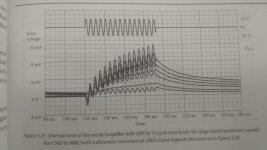So how does one measure transient response?
One way looks to be short bursts of sine captured with a mic and compared on a scope.
Is there a database of common speakers or is this strictly amp/box related?
I’m assuming there must be expected traits tied to the speaker construction.....this paper states phase plugs are no bueno for transient response, and my de250’s have just such plugs!
https://www.fulcrum-acoustic.com/wp...dspeaker-transient-response-with-dsp-2005.pdf
One way looks to be short bursts of sine captured with a mic and compared on a scope.
Is there a database of common speakers or is this strictly amp/box related?
I’m assuming there must be expected traits tied to the speaker construction.....this paper states phase plugs are no bueno for transient response, and my de250’s have just such plugs!
https://www.fulcrum-acoustic.com/wp...dspeaker-transient-response-with-dsp-2005.pdf
Last edited:
>One way looks to be short bursts of sine captured with a mic and compared on a scope.
I remember D'Appolito doing that some 25 years ago; he'd show the input sine burst on one trace and the speaker response on another. There was a slight delay at the beginning and a slight trail at the end.
I bet you could make a circuit using a SS relay to do half-sines directly from the wall AC outlet - that would give your bass drivers a "kick"! Probably wouldnt hurt them at all - as long as you didnt press the button too many times in a row...
I remember D'Appolito doing that some 25 years ago; he'd show the input sine burst on one trace and the speaker response on another. There was a slight delay at the beginning and a slight trail at the end.
I bet you could make a circuit using a SS relay to do half-sines directly from the wall AC outlet - that would give your bass drivers a "kick"! Probably wouldnt hurt them at all - as long as you didnt press the button too many times in a row...
An objective measurement requires the use of a physical objective unit.bimo said:what measurement is objective
"Cleanliness of sound" is not equivalent to "musical sound". The latter is often the result of second harmonic distortion or some other distortion that sounds pleasing to most people.
In some way, "un-cleanliness of sound" can be defined objectively as the fractional power contribution from harmonics not present in the source signal.
Nice idea. I'm thinking in the states that could be done, but here in europe, I'm not gonna take too many chances with 230 volts
Stupid V Squared by R...
"Cleanliness of sound" is not equivalent to "musical sound". The latter is often the result of second harmonic distortion or some other distortion that sounds pleasing to most people.
Dr. Gedlee research to harmonic profile of distortion and found human is sensitive to high order harmonic distortion.
Hugh Dean (AKSA) advocated to make monotonic harmonic profile of distortion. I found class A amplifier have monotonic harmonic profile of distortion, but class AB amplifier can have too, like Pelatuk amplifier, one of my amplifier. But my personal preference is I like low distortion in all audio frequency. Bob Cordell advocated to make distortion at 20 kHz is lowest as possible and I agree. Distortion at 20 kHz should almost same level as distortion at 1 kHz.
An objective measurement requires the use of a physical objective unit.
This is a beauty!
An objective unit is a number...no critical endeavour used "that's about right", or, "that feels about right".
The guidance systems aboard Apollo didn't apply numbers that were "about", or "close enough"...granted, we have margins, ranges, but when we apply indistinct attributes we're not exacting.
No doubt there are attributes within music that "sound" different, but that merely shows us that we have not yet discovered a metric system yet to differentiate the differences.
-----------------------------------------------------------------------Rick.....
The guidance systems aboard Apollo didn't apply numbers that were "about", or "close enough"...granted, we have margins, ranges, but when we apply indistinct attributes we're not exacting.
No doubt there are attributes within music that "sound" different, but that merely shows us that we have not yet discovered a metric system yet to differentiate the differences.
-----------------------------------------------------------------------Rick.....
- Status
- This old topic is closed. If you want to reopen this topic, contact a moderator using the "Report Post" button.
- Home
- Member Areas
- The Lounge
- Measurement and Perception
